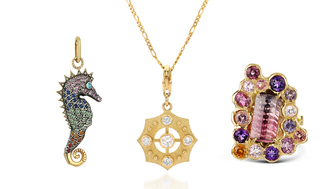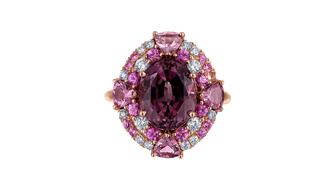AGTA Bans Lab-Grown Diamonds, Gemstones at GemFair
Members can still sell lab-grown stones, it said, but only natural gems are allowed on the show floor.

National Jeweler received a news release on AGTA’s decision via email Wednesday morning. The release also was posted on the AGTA website, though it had been removed by Wednesday evening.
AGTA CEO John W. Ford Sr. said the news release was “pulled by error,” and would be reposted today.
According to the release, AGTA’s new rule bans the display of loose gemstones or jewelry “comprising non-natural gemstones, ones that are man-made, synthetic, or lab grown.”
AGTA said its dealers can still sell lab-grown gems if they are disclosed, but only natural gems can be made available for purchase at GemFair.
The association said it enacted the ban to “thwart potential confusion,” confusion it sees happening in the lab-grown diamond industry and fears will affect the colored gemstone industry, even though lab-grown colored stones have been around for more than a century.
When asked what led to the belief that confusion was occurring, or could occur, in the colored gemstone market, Ford said in an email to National Jeweler, “Look no further than the chaos created by synthetics in the diamond industry … Our action is also in response to considerable concerns voiced by AGTA membership in relation to the adverse effects that synthetics could also potentially cause in the colored gemstone industry.”
While the AGTA’s decision has made headlines, it does not seem poised to have a big impact on AGTA GemFair exhibitors, few of whom sell lab-grown gemstones anyway.
In his email, Ford said out of the 260 exhibitors of loose or set gemstones at the 2024 AGTA GemFair Tucson, only two list that they sell synthetic gemstones in the AGTA Source Directory.
“Since sending out over (260) 2025 AGTA GemFair Tucson renewals, we’ve had an overwhelmingly positive response from the vast majority of our exhibitors, greatly outweighing any negative responses,” he said.
In its news release, AGTA also noted that lab-grown gemstones lack the value inherent to natural gemstones, which are rare and sometimes inimitable.
“AGTA felt that it needed to be crystal clear to buyers that when they attend an AGTA show, they know that they are only shopping mined natural gems from the earth,” said Kimberly Collins, AGTA board president and owner of Kimberly Collins Colored Gems.
“AGTA dealers pride themselves in sourcing superior gems that are rare, beautiful, and natural.”
AGTA also notes that “synthetic gems are not minerals.”
The association said it recognizes two definitions of the word “mineral”—that of the British Geological Survey, defining a mineral as “a naturally occurring substance with distinctive chemical and physical properties, composition, and atomic structure” and that of the U.S. Geological Survey, which defines a mineral as a “naturally occurring inorganic element or compound having an orderly internal structure and characteristic chemical composition, crystal form, and physical properties.”
“The definitions are essentially the same, but the keyword in both that is important is use of the word ‘natural,’” said AGTA board member John Bradshaw.
“It’s important to indicate that synthetic gems are not considered minerals, because minerals are natural, and synthetics are not.”
The Latest

As the shopping mall model evolves and online retail grows, Smith shares his predictions for the future of physical stores.

The trade show is slated for Jan. 31-Feb. 2 at The Lighthouse in New York City's Chelsea neighborhood.

January’s birthstone comes in a rainbow of colors, from the traditional red to orange, purple, and green.

How Jewelers of America’s 20 Under 40 are leading to ensure a brighter future for the jewelry industry.

The annual report highlights how it supported communities in areas where natural diamonds are mined, crafted, and sold.


Footage of a fight breaking out in the NYC Diamond District was viewed millions of times on Instagram and Facebook.

The supplier has a curated list of must-have tools for jewelers doing in-house custom work this year.

Roseco’s 704-page catalog showcases new lab-grown diamonds, findings, tools & more—available in print or interactive digital editions.

The Signet Jewelers-owned store, which turned 100 last year, calls its new concept stores “The Edit.”

Linda Coutu is rejoining the precious metals provider as its director of sales.

The governing board welcomed two new members, Claire Scragg and Susan Eisen.

Sparkle with festive diamond jewelry as we celebrate the beginning of 2026.

The master jeweler, Olympian, former senator, and Korean War veteran founded the brand Nighthorse Jewelry.

In its annual report, Pinterest noted an increase in searches for brooches, heirloom jewelry, and ‘80s luxury.

Executive Chairman Richard Baker will take over the role as rumors swirl that a bankruptcy filing is imminent for the troubled retailer.

Mohr had just retired in June after more than two decades as Couture’s retailer liaison.

Shekhar Shah of Real Gems Inc. will serve as president of the Indian Diamond & Colorstone Association in 2026.

This year’s good luck charm features the mythical horse Pegasus, and is our first Piece of the Week of the new year.

Articles about crime, engagement rings, and a necklace worn in the World Series generated the most interest among readers.

As part of the leadership transition, Sherry Smith will take on the role of vice president of coaching strategy and development.

It marks the third time the country has headed the Kimberley Process. Ghana will serve as vice chair.

The new Bulova x Stetson designs highlight two animals often associated with the American West—the bison and the Texas Longhorn.

Its residency at Yamron Jewelers will run through May 2026.

From influential executives to innovative designers, we pay tribute to the people we said goodbye to this year.

The retailer is expanding into areas with large Indian and South Asian populations.

The Italian brand has opened its first flagship amid the peaks of the Dolomites in Madonna di Campiglio, Italy.

The new curation at the Natural History Museum of Los Angeles County showcases rare gem and mineral specimens in their uncut, natural state.





























